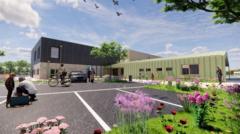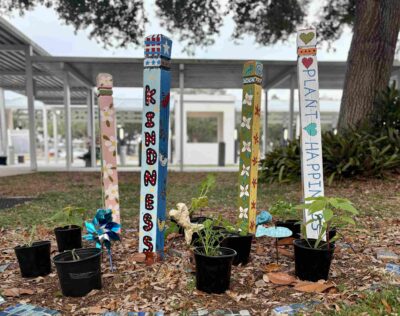Report on the North Tama County Community School District Strategic Plan Initiative
Introduction
The North Tama County Community School District has initiated a strategic planning process to establish long-term goals and a framework for achieving them. This process is designed to align district resources, foster community support, and improve student outcomes. The draft plan demonstrates a significant commitment to the United Nations Sustainable Development Goals (SDGs), particularly in the areas of education, well-being, economic growth, and community partnership.
Alignment with Sustainable Development Goals (SDGs)
The district’s strategic plan draft is fundamentally aligned with several key SDGs. The core priorities and values reflect a comprehensive approach to creating a sustainable and equitable future for students and the community.
SDG 4: Quality Education
The primary focus of the strategic plan is to ensure inclusive and equitable quality education and promote lifelong learning opportunities for all, directly supporting SDG 4.
- Vision – “Opening Doors to Lifelong Learning”: This statement directly supports SDG Target 4.3, which aims to ensure equal access for all to affordable and quality technical, vocational, and tertiary education.
- Mission Statement: The commitment to “prepare all students for their future success by providing rigorous academic experiences in a safe, student-centered learning environment” aligns with SDG Target 4.1, which seeks to ensure that all children complete free, equitable, and quality primary and secondary education.
- Core Priorities:
- Academic Improvement & Student Learning: This priority targets continuous academic growth and support systems for every learner, contributing to SDG 4.1 and SDG 4.5 (eliminate gender disparities in education and ensure equal access for the vulnerable).
- Career & Future Readiness: By offering real-world learning and essential skills, the district addresses SDG Target 4.4, which aims to substantially increase the number of youth and adults who have relevant skills for employment and decent jobs.
SDG 3: Good Health and Well-being
The plan emphasizes the physical and mental health of the school community, a key component of SDG 3.
- Core Priority – School Safety: The goal to “prioritize the safety and well-being of all students and staff” contributes to SDG Target 3.4, which seeks to promote mental health and well-being.
- Core Value – Safe & Welcoming Environments: The belief in fostering an environment where “mental and physical health needs are valued and respected” reinforces the district’s commitment to SDG 3.
Additional SDG Contributions
The strategic plan also incorporates principles from other critical SDGs:
- SDG 8: Decent Work and Economic Growth: The “Future Ready” value, which aims to equip students for the workforce or higher education, supports SDG Target 8.6 to reduce the proportion of youth not in employment, education, or training.
- SDG 9: Industry, Innovation, and Infrastructure: The “Facilities & Property” priority, focused on maintaining and improving school facilities, aligns with SDG Target 9.1 to develop quality, reliable, and sustainable infrastructure, as well as SDG Target 4.a to build and upgrade education facilities.
- SDG 12: Responsible Consumption and Production: The “Fiscal Responsibility” value promotes the sustainable management and efficient use of financial resources, reflecting the principles of SDG 12.
- SDG 17: Partnerships for the Goals: The “Community Involvement & Partnerships” value underscores the importance of collaboration, which is the central theme of SDG 17, specifically Target 17.17, which encourages effective public and civil society partnerships.
Public Consultation and Community Engagement
In alignment with SDG 16 (Peace, Justice, and Strong Institutions), which calls for responsive, inclusive, and participatory decision-making, the district is actively seeking public feedback. Residents of the North Tama district are invited to review the draft plan and provide input on its Vision, Mission, Core Priorities, and Values.
- Deadline for Response: November 1, 2025
- Feedback Form Access: https://tinyurl.com/NTStrategicPlan
Analysis of the North Tama School District’s Strategic Plan in Relation to SDGs
1. Which SDGs are addressed or connected to the issues highlighted in the article?
-
SDG 4: Quality Education
This is the most prominent SDG addressed in the article. The entire text focuses on the North Tama County Community School District’s strategic plan, which is fundamentally about providing quality education. The plan’s vision, “Opening Doors to Lifelong Learning,” and its mission to “prepare all students for their future success by providing rigorous academic experiences” directly align with the core objective of SDG 4.
-
SDG 17: Partnerships for the Goals
The article highlights the district’s effort to involve the community in its strategic planning process. By asking residents to “participate in the district’s strategic planning” and seeking feedback, the district is actively engaging in multi-stakeholder partnerships. This is further reinforced by the core belief in “Community Involvement & Partnerships,” which states that “strong communication and collaboration among the students, families, District and the community are essential to student success.”
2. What specific targets under those SDGs can be identified based on the article’s content?
-
Target 4.1: Ensure that all girls and boys complete free, equitable and quality primary and secondary education.
The district’s mission to “prepare all students for their future success” and its core priority of “Academic Improvement & Student Learning” aim to achieve effective learning outcomes for every student, which is the essence of this target.
-
Target 4.4: Substantially increase the number of youth and adults who have relevant skills, including technical and vocational skills, for employment, decent jobs and entrepreneurship.
This target is directly addressed by the core priority of “Career & Future Readiness.” The plan explicitly aims to “prepare students for success beyond graduation by offering real-world learning experiences, career exploration, and essential skills for the modern workforce.”
-
Target 4.a: Build and upgrade education facilities that are child, disability and gender sensitive and provide safe, non-violent, inclusive and effective learning environments for all.
The article clearly connects to this target through two core priorities: “School Safety” and “Facilities & Property.” The district commits to “prioritize the safety and well-being of all students and staff by creating secure, welcoming environments” and to “maintaining and improving school facilities to ensure a safe, functional, and inspiring learning environment.”
-
Target 17.17: Encourage and promote effective public, public-private and civil society partnerships.
The entire premise of the article—a public call for community feedback on a strategic plan—is an example of this target in action. The district is actively building a partnership with its community (“residents are being asked to participate”) to align resources and enhance support, as mentioned in the article.
3. Are there any indicators mentioned or implied in the article that can be used to measure progress towards the identified targets?
-
Implied Indicator for Target 4.1: Measures of Student Outcomes
The article states that a strategic plan helps in “ultimately improving student outcomes.” While it does not specify the metrics, this implies the use of indicators such as graduation rates, standardized test scores, and proficiency levels in various subjects to measure the effectiveness of the academic experiences provided.
-
Implied Indicator for Target 4.4: Participation in Career-Focused Programs
The focus on “Career & Future Readiness” and “real-world learning experiences” implies that the district would track the number or proportion of students participating in career exploration programs, internships, or vocational training courses as a measure of success.
-
Implied Indicator for Target 4.a: Quality and Safety of School Facilities
The commitment to “maintaining and improving school facilities” and ensuring “safe, secure, and supportive environment” implies that progress would be measured by indicators related to the physical condition of school buildings, the implementation of safety protocols, and surveys of student and staff perceptions of safety and well-being.
-
Implied Indicator for Target 17.17: Level of Community Engagement
The district’s call for feedback via a specific form (“Those who live in the North Tama district are asked to respond by Nov. 1, 2025”) implies that the number of responses received and the level of community participation in the planning process can be used as an indicator to measure the strength of the community partnership.
4. Table of SDGs, Targets, and Indicators
| SDGs | Targets | Indicators (as identified or implied in the article) |
|---|---|---|
| SDG 4: Quality Education | Target 4.1: Ensure quality primary and secondary education. | Implied: Measures of student outcomes (e.g., graduation rates, test scores) to track progress on “improving student outcomes.” |
| SDG 4: Quality Education | Target 4.4: Increase the number of youth and adults with relevant skills for employment. | Implied: Number of students participating in “real-world learning experiences” and “career exploration” programs. |
| SDG 4: Quality Education | Target 4.a: Build and upgrade education facilities to be safe and inclusive. | Implied: Assessments of facility conditions and surveys on the perception of “safe, secure, and supportive environments.” |
| SDG 17: Partnerships for the Goals | Target 17.17: Encourage and promote effective public partnerships. | Implied: The number of responses to the strategic plan survey as a measure of community participation and engagement. |
Source: northtamatelegraph.com







